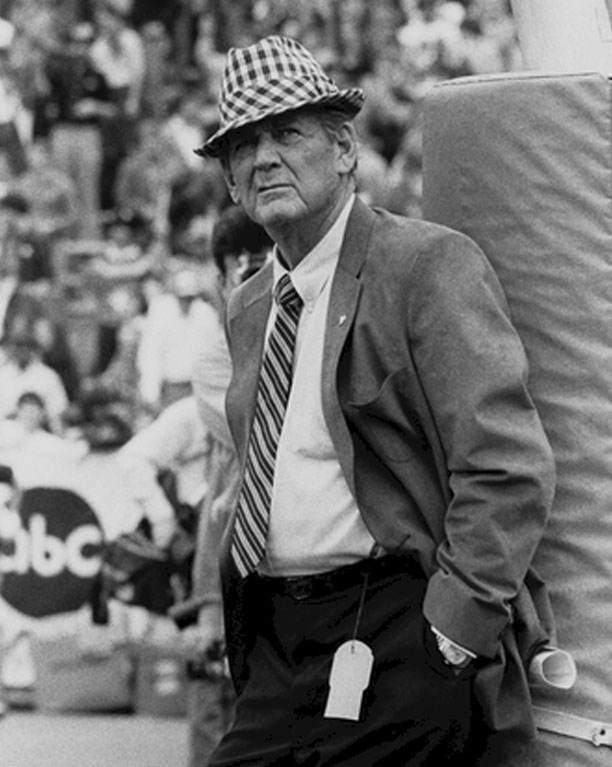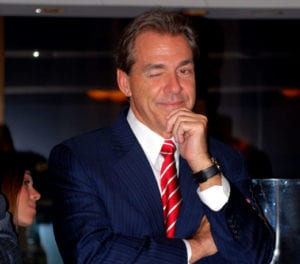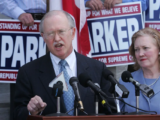Bear Bryant was interviewed by students at Birmingham’s Parker High School in 1973 –
Please click on this link and hit subscribe to our YouTube channel to help save us from losing advertising revenue (see explanation below).
Students interview University of Alabama football coach Paul “Bear” Bryant at Parker High School in Birmingham the day before the A-Day game in the spring of 1973. Filmed by teacher Dan Fulton. Converted and published by Glynn Wilson.
By Glynn Wilson –
Seven years ago I was toiling away covering news as an independent reporter on the web out of Birmingham, Alabama, when I first put up a YouTube channel and began producing news videos to go with stories. It all started during the BP Gulf oil spill disaster that spring and summer.
One of my new friends on Facebook in those days was a retired high school teacher named Dan Fulton. I just recently found out that he has died. There is a memorial page for him on Facebook: Dan Fulton.
He had become a fan of my work back in 2007 when I was covering the political prosecution of former Alabama Governor Don Siegelman for The Locust Fork News-Journal.
After Mark Ingram won the first ever Heisman Trophy for Alabama and the Crimson Tide went on to win it’s first national championship under new head coach Nick Saban, Fulton contacted me one day and let me know that he had been a teacher at Parker High School back in the days when Paul “Bear” Bryant was the head football coach, and that he had invited Bryant to speak at his school in 1973.
He had film footage of the event but did not know how to convert it to a digital format and no way to publish it online. He offered me an exclusive on the video if I could help make it possible for this video to live on in the internet age. So I worked with him to get the video converted onto a DVD and then into MP3 format, and then published it on YouTube.
I did some research for a story to go with the video, with Fulton’s help, and published it here. The famous coach is interviewed by a group of Boy Scouts and students at Hill Elementary School, just down the street from Parker High School.
Since then the video has received quite a bit of traffic on the web and a number of comments. As of this day, Feb. 7, 2018, it had been viewed by 45,278 people. It was liked by 99 and had 36 comments, not counting all the racist crap I’ve deleted over the years.
We are republishing it today on the New American Journal website for a good reason. Fulton liked me and my journalism and wanted to help me succeed. In Alabama terms, 45,000 views on a video is quite viral. But out there on the global web, viral means a million views or more. To make any significant money on Google Adsense ads, a website or video needs to get past the 1 million hit mark.
The problem now is, Google, the tech giant out of California which now owns YouTube, is changing its policy on ads placed on videos. They are about to require at least 1,000 subscribers on a channel for publishers to “monetize” videos, along with 4,000
hours of viewing time over 12 months.
Since I do not produce a daily news broadcast or a podcast and only do occasional news videos to go with my stories, and I have not really focused on getting subscribers over the past seven years, we only have 216 subscribers. This means by Feb. 20, all the ads on all our YouTube videos will be disabled and we will lose any ability to earn revenue from them over time or on new videos.
The promise of this new technology has long been that if you work long and hard enough, eventually you will get enough traffic to be compensated for all the time you put into this endeavor. All the traffic in the world makes no difference if you don’t have an advertising interface to capitalize on it.
Many of the videos we have produced have had tangible results on politics and the environment, even if they didn’t get a million hits and earn a lot of money. There is no doubt that our work helped get Doug Jones elected over Roy Moore in the special U.S. Senate election in Alabama.
John Lewis Campaigns for Doug Jones in Mobile
We helped change the subject in Montgomery two years ago and helped save funding for Medicaid too.
Alabama Senator Leads Republican Death Panel
A few years back, we helped stop fracking in the Talladega National Forest.
Going forward, we can continue to make a difference. But we need your help now.
Please click on this link and subscribe to our YouTube channel to help save us from losing ad revenue.
—
This is the story we published back then. I consider it to be the definitive coverage of the controversy about Bryant recruiting the first African American players at Alabama.
By Glynn Wilson –
The young people were all Boy Scouts and students at Hill Elementary School, down the street from Parker High School, Fulton said in a telephone interview after sending me the DVD and MP4 file. Holding the microphone to the right of Coach Bryant is Fidel Patterson. To the left is Kerry Seals. Facing Coach Bryant is Reginald Jones.
It was also Wendell Hudson Day. Hudson is now the eighth head women’s basketball coach at the University of Alabama.
Bryant had already integrated the team with African-Americans, non-scholarship, walk-on players, by the early 1970s.
During a deposition in a lawsuit filed in 1969 by U.W. Clemon for the Afro-American Association of the University of Alabama, however, Bryant said his staff had been scouting black players as early as 1966.
But it wasn’t until five months after the federal lawsuit was filed that Alabama signed its first black football player to a scholarship in 1970, Wilbur Jackson. The next year another player became the first black to appear in a varsity football game for Alabama.
According to the Alabama Associated Press account of the story, Bryant recalled telling a black high school coach that it was “a little too soon” to have a black player at Alabama and implied that the state’s racial climate was a “problem.”
The suit was dismissed in 1971 after the university gave a handful of scholarships to black athletes, according to AP, and that’s when the monitoring by the FBI ended too. Bryant’s FBI file ran 27 pages.
Clemon said in an interview that black high school coaches would have testified that Alabama didn’t seem truly interested in attracting black players until after the loss to Southern California in 1970. The game was viewed by many as opening fans’ eyes to the idea that racial integration was inevitable if Alabama wanted to have a successful football program.
“Bear Bryant got religion after the USC game, and it was dismissed without trial,” Clemon said, although his view has been disputed by some. Some accounts indicate Bryant wanted black players sooner than the university administration and powerful alumni of the day, but perhaps the USC game did help end some of the opposition.
The 1973 season, when this video was filmed, was the first year Alabama won a national championship with scholarship black players, although they had to share the title with Notre Dame after losing to the Fighting Irish 24–23 in the Sugar Bowl. The 1973 Alabama football team was selected national champions in the final Coaches’ Poll prior to the bowl games.
Because of the controversy after the bowl loss, the Coaches’ Poll began selecting their champion after the bowl games starting in 1974. The AP poll placed Alabama 4th that year, and selected Notre Dame as its top team after the season.















